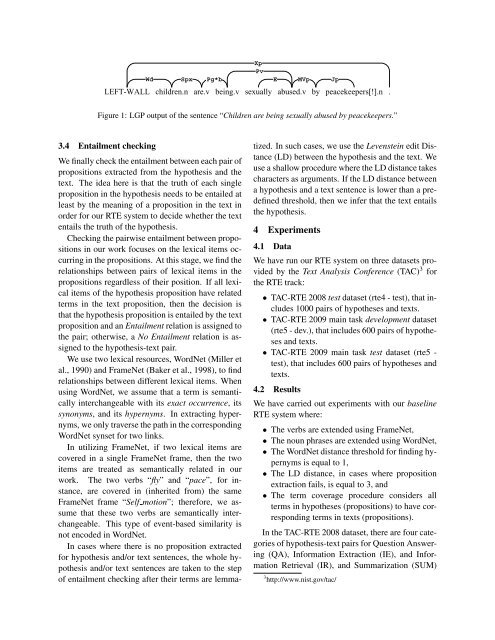From Lexical Entailment to Recognizing Textual Entailment Using ...
From Lexical Entailment to Recognizing Textual Entailment Using ...
From Lexical Entailment to Recognizing Textual Entailment Using ...
You also want an ePaper? Increase the reach of your titles
YUMPU automatically turns print PDFs into web optimized ePapers that Google loves.
Xp<br />
Pv<br />
Wd Spx Pg*b<br />
E MVp Jp<br />
LEFT-WALL children.n are.v being.v sexually abused.v by peacekeepers[!].n .<br />
Figure 1: LGP output of the sentence “Children are being sexually abused by peacekeepers.”<br />
3.4 <strong>Entailment</strong> checking<br />
We finally check the entailment between each pair of<br />
propositions extracted from the hypothesis and the<br />
text. The idea here is that the truth of each single<br />
proposition in the hypothesis needs <strong>to</strong> be entailed at<br />
least by the meaning of a proposition in the text in<br />
order for our RTE system <strong>to</strong> decide whether the text<br />
entails the truth of the hypothesis.<br />
Checking the pairwise entailment between propositions<br />
in our work focuses on the lexical items occurring<br />
in the propositions. At this stage, we find the<br />
relationships between pairs of lexical items in the<br />
propositions regardless of their position. If all lexical<br />
items of the hypothesis proposition have related<br />
terms in the text proposition, then the decision is<br />
that the hypothesis proposition is entailed by the text<br />
proposition and an <strong>Entailment</strong> relation is assigned <strong>to</strong><br />
the pair; otherwise, a No <strong>Entailment</strong> relation is assigned<br />
<strong>to</strong> the hypothesis-text pair.<br />
We use two lexical resources, WordNet (Miller et<br />
al., 1990) and FrameNet (Baker et al., 1998), <strong>to</strong> find<br />
relationships between different lexical items. When<br />
using WordNet, we assume that a term is semantically<br />
interchangeable with its exact occurrence, its<br />
synonyms, and its hypernyms. In extracting hypernyms,<br />
we only traverse the path in the corresponding<br />
WordNet synset for two links.<br />
In utilizing FrameNet, if two lexical items are<br />
covered in a single FrameNet frame, then the two<br />
items are treated as semantically related in our<br />
work. The two verbs “fly” and “pace”, for instance,<br />
are covered in (inherited from) the same<br />
FrameNet frame “Self motion”; therefore, we assume<br />
that these two verbs are semantically interchangeable.<br />
This type of event-based similarity is<br />
not encoded in WordNet.<br />
In cases where there is no proposition extracted<br />
for hypothesis and/or text sentences, the whole hypothesis<br />
and/or text sentences are taken <strong>to</strong> the step<br />
of entailment checking after their terms are lemmatized.<br />
In such cases, we use the Levenstein edit Distance<br />
(LD) between the hypothesis and the text. We<br />
use a shallow procedure where the LD distance takes<br />
characters as arguments. If the LD distance between<br />
a hypothesis and a text sentence is lower than a predefined<br />
threshold, then we infer that the text entails<br />
the hypothesis.<br />
4 Experiments<br />
4.1 Data<br />
We have run our RTE system on three datasets provided<br />
by the Text Analysis Conference (TAC) 3 for<br />
the RTE track:<br />
• TAC-RTE 2008 test dataset (rte4 - test), that includes<br />
1000 pairs of hypotheses and texts.<br />
• TAC-RTE 2009 main task development dataset<br />
(rte5 - dev.), that includes 600 pairs of hypotheses<br />
and texts.<br />
• TAC-RTE 2009 main task test dataset (rte5 -<br />
test), that includes 600 pairs of hypotheses and<br />
texts.<br />
4.2 Results<br />
We have carried out experiments with our baseline<br />
RTE system where:<br />
• The verbs are extended using FrameNet,<br />
• The noun phrases are extended using WordNet,<br />
• The WordNet distance threshold for finding hypernyms<br />
is equal <strong>to</strong> 1,<br />
• The LD distance, in cases where proposition<br />
extraction fails, is equal <strong>to</strong> 3, and<br />
• The term coverage procedure considers all<br />
terms in hypotheses (propositions) <strong>to</strong> have corresponding<br />
terms in texts (propositions).<br />
In the TAC-RTE 2008 dataset, there are four categories<br />
of hypothesis-text pairs for Question Answering<br />
(QA), Information Extraction (IE), and Information<br />
Retrieval (IR), and Summarization (SUM)<br />
3 http://www.nist.gov/tac/














